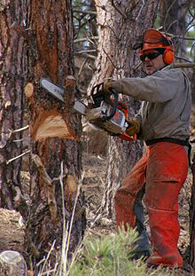
A chainsaw is a portable mechanical saw, powered by electricity, compressed air, hydraulic power, or most commonly a two-stroke engine. They can also clear fallen branches after a storm in a fraction of the time you'd spend with a hand saw.
| | Chain saws range from small, light-duty electrics to large gas-powered models intended for forestry work. Chainsaws with specially designed bar and chain combinations have been developed as tools for use in chainsaw art. Specialist chainsaws are used for cutting concrete. Chainsaws are also used for cutting ice, for example in Finland for avantouinti. The kinds of jobs you plan to do should dictate the type of chain saw you buy. Here's what you need to know before you shop. |
Types
Decide which type of chain saw you'll buy--gas or electric, corded or cordless--based on the kind of sawing you'll do, how often you'll do it, and how far from a power outlet you plan to work.
| Gas-powered chain saws | |
| Electric chain saws | |
Features
Safety tops the list when it comes to chain-saw features, followed by convenience and ease of use--especially since a heavy, clumsy saw can contribute to fatigue and carelessness.
| Reduced-kickback chain Extra guard links and a less-aggressive cutting profile help keep the chain from taking too large a bite, which could cause kickback. Most saws now include this feature. Reduced-kickback bar Most chain saws have a bar with a narrow tip or nose to limit the cutting area that generates most kickback. |
| Chain brake This feature stops the chain almost instantly when the front hand guard is pushed forward or if the saw kicks back. Most gas-powered saws and many electrics now have one. >>More | |
Safety
| Despite safety features and protective clothing, injuries can still arise from chainsaw use, from the large forces involved in the work, from the fast-moving, sharp chain, or from the vibration and noise of the machinery. A common accident arises from kickback, when a chain tooth at the tip of the guide bar catches on wood without cutting through it.This throws the bar (with its moving chain) in an upward arc toward the operator which can cause serious injury or even death. Another dangerous situation occurs when heavy timber begins to fall or shift before a cut is complete — the chainsaw operator may be trapped or crushed. Similarly, timber falling in an unplanned direction may harm the operator or other workers, or an operator working at a height may fall or be injured by falling timber. Gasoline-powered chainsaws expose operators to harmful carbon monoxide (CO) gas, especially indoors or in partially enclosed outdoor areas | |
Brands
Many makers of outdoor power equipment also make chain saws. Use these profiles to compare chain saws by brand.
| | | |
| |
| |
Written by Nicolas Yang













